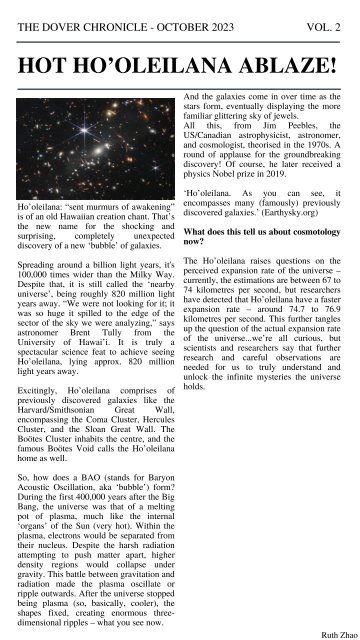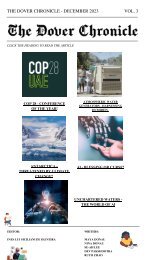THE DOVER CHRONICLE VOL 2
Create successful ePaper yourself
Turn your PDF publications into a flip-book with our unique Google optimized e-Paper software.
<strong>THE</strong> <strong>DOVER</strong> <strong>CHRONICLE</strong> - OCTOBER 2023 <strong>VOL</strong>. 2<br />
HOT HO’OLEILANA ABLAZE!<br />
And the galaxies come in over time as the<br />
stars form, eventually displaying the more<br />
familiar glittering sky of jewels.<br />
All this, from Jim Peebles, the<br />
US/Canadian astrophysicist, astronomer,<br />
and cosmologist, theorised in the 1970s. A<br />
round of applause for the groundbreaking<br />
discovery! Of course, he later received a<br />
physics Nobel prize in 2019.<br />
Ho’oleilana: “sent murmurs of awakening”<br />
is of an old Hawaiian creation chant. That’s<br />
the new name for the shocking and<br />
surprising, completely unexpected<br />
discovery of a new ‘bubble’ of galaxies.<br />
Spreading around a billion light years, it's<br />
100,000 times wider than the Milky Way.<br />
Despite that, it is still called the ‘nearby<br />
universe’, being roughly 820 million light<br />
years away. “We were not looking for it; it<br />
was so huge it spilled to the edge of the<br />
sector of the sky we were analyzing,” says<br />
astronomer Brent Tully from the<br />
University of Hawai’i. It is truly a<br />
spectacular science feat to achieve seeing<br />
Ho’oleilana, lying approx. 820 million<br />
light years away.<br />
Excitingly, Ho’oleilana comprises of<br />
previously discovered galaxies like the<br />
Harvard/Smithsonian Great Wall,<br />
encompassing the Coma Cluster, Hercules<br />
Cluster, and the Sloan Great Wall. The<br />
Boötes Cluster inhabits the centre, and the<br />
famous Boötes Void calls the Ho’oleilana<br />
home as well.<br />
So, how does a BAO (stands for Baryon<br />
Acoustic Oscillation, aka ‘bubble’) form?<br />
During the first 400,000 years after the Big<br />
Bang, the universe was that of a melting<br />
pot of plasma, much like the internal<br />
‘organs’ of the Sun (very hot). Within the<br />
plasma, electrons would be separated from<br />
their nucleus. Despite the harsh radiation<br />
attempting to push matter apart, higher<br />
density regions would collapse under<br />
gravity. This battle between gravitation and<br />
radiation made the plasma oscillate or<br />
ripple outwards. After the universe stopped<br />
being plasma (so, basically, cooler), the<br />
shapes fixed, creating enormous threedimensional<br />
ripples – what you see now.<br />
‘Ho’oleilana. As you can see, it<br />
encompasses many (famously) previously<br />
discovered galaxies.’ (Earthysky.org)<br />
What does this tell us about cosmotology<br />
now?<br />
The Ho’oleilana raises questions on the<br />
perceived expansion rate of the universe –<br />
currently, the estimations are between 67 to<br />
74 kilometres per second, but researchers<br />
have detected that Ho’oleilana have a faster<br />
expansion rate – around 74.7 to 76.9<br />
kilometres per second. This further tangles<br />
up the question of the actual expansion rate<br />
of the universe...we’re all curious, but<br />
scientists and researchers say that further<br />
research and careful observations are<br />
needed for us to truly understand and<br />
unlock the infinite mysteries the universe<br />
holds.<br />
Ruth Zhao

















